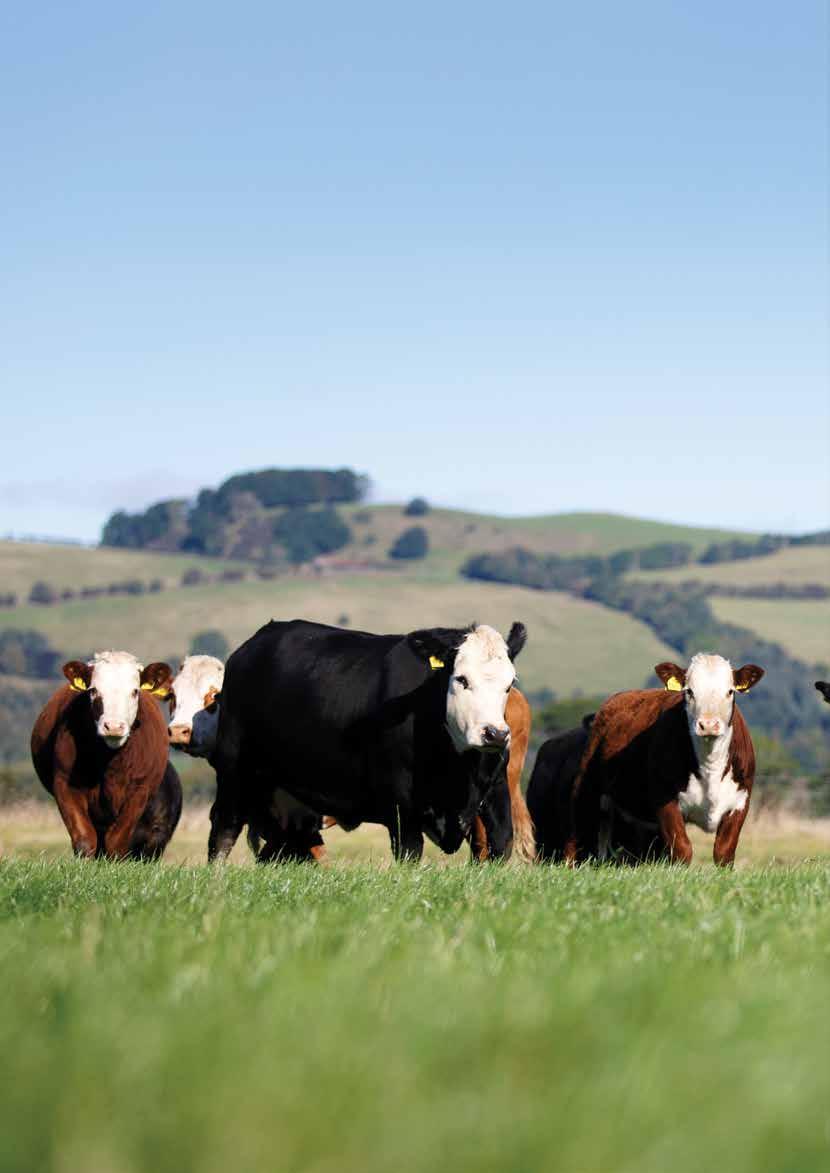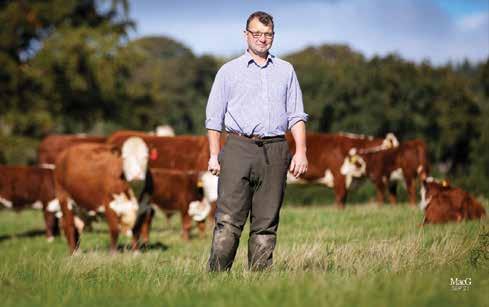
6 minute read
Hereford breed suits share farming set-up

With a history of managing Limousins, Iain Wilkinson has in recent years been introduced to the Hereford and says the breed is definitely the right one for his farming systems.
Aside from the many other benefits, it was the superior eating quality of Hereford Beef that was one of the main factors involved in Perthshire-based Iain Wilkinson’s decision to invest in the breed.
“It’s important to me to be producing something that I am proud of and that’s certainly the case with Hereford Beef. The flavour is outstanding. We’ve actually got friends who had stopped buying beef because they couldn’t get the quality they were looking for and they’re back eating it again after trying Hereford,” says Iain, who is based at Balgay, Inchture, Perthshire with his wife Jennifer, a local vet.
Having managed the cattle herd for the Alexander family at Mains of Mause, Blairgowrie for 25 years, Iain moved to Balgay in 2017, where he works a shared farming agreement with owners Iain and Sheena Graham. On the 405 hectare (1,000 acre) farm, Iain manages 100 cows for the Grahams and runs 80 cows and 480 ewes of his own. He also contract manages the arable side of the business, which includes 304ha (750ac) of winter cereals and oilseed rape, plus he rents a further 162ha (400ac) of upland ground through seasonal lets while contract managing 400 ewes on another holding. Iain had worked with a Limousin-based suckler herd at Mains of Mause, but first became keen on the Hereford breed in 2015, after attending the Ervie bull sale in Stranraer.
“I was blown away by the Hereford cows at Ervie due to their temperament, ease of management and ability to put on flesh off grass,” he explains.
Iain was so impressed that he returned later that year and bought five cows from Ervie, establishing his Redstroke Hereford herd. Then, in February 2016, he purchased the bull, Ervie Advance 141836.
“My plan was to use the bull on the pedigree cows I had bought from Ervie and Limousin cows which I already had. Then, when this opportunity came up at Balgay, I decided to go down the Hereford route when expanding my own herd.
“I visited Robert Parker’s Drumdow herd and was very impressed with his cattle and he had used a lot of Ervie bulls, crossing with the Angus to produce Black Baldy calves. That was a big influence on my decision to increase my Hereford numbers too,” says Iain. Building up the herd, Iain worked away crossing the Hereford over his own cows and the Balgay cows, buying resultant Black Baldy female calves from the Balgay herd, to use in his own.
“I really like the Black Baldy females. They are fertile, with good feet and udders and have longevity too,” he says. Within the pedigree Herefords, Iain had been getting far more bull calves than heifers, so he went back to Ervie in 2020 and bought 10 more heifers. The pedigree numbers now sit at 22 cows and six in-calf heifers.
“With the females, I’ve tried to buy them as young as possible and from different bloodlines, looking particularly at legs, udders and tops. I’m aiming for a moderate sized cow that is easy to keep and still produces the carcase size that the market wants.”
Having used the Ervie bull heavily on the pedigree and commercial cows, Iain recently bought a new stock bull, Netherhall L1 Planet 643. Carrying Line One breeding it started out as an embryo from the Holden herd in Montana and Iain has high hopes for him after seeing his progeny at Netherhall.
The 60 commercial cows are now all put to the Hereford or Limousin bull, a native and continental-cross that Iain thinks

Iain Wilkinson runs a commercial herd of Hereford sucklers and Redstroke Herefords

works well. He selects some of the heifer calves to keep for replacements and the rest are finished on-farm. “All the finished cattle are sold to ABP at Perth, with the steers away at between 12 to 18 months. They are fattened on a home-grown barley and silage-based ration. The last batch of 20 Hereford and Hereford-cross steers went at an average weight of 349.5kg at 15.3 months,” explains Iain. “I’m considering moving towards a grass-based finishing system. It would take longer to finish the cattle, but I think the Herefords would do well on that type of set-up. At the moment, it makes sense to get them away a bit quicker, when we have the sheds here anyway, and the home-grown feed.” Heifer calves are finished later, at between 18 and 22 months. They come in off grass for their second winter and are given ad-lib good quality silage, plus a little grain if needed. Pedigree heifers and bulls that are not being kept for breeding or selling privately, are also finished. Iain has been selling some of that beef boxed to local customers, which has proved very popular. “Anyone who has tried our Hereford Beef has loved it. I’m a big steak fan, but I rarely have one when we go out now – they’re never as good as what I can get at home.”
Farm facts
• Share farming agreement with owners Iain and Sheena Graham
• 405 hectare (1,000 acre) farm

• Manages 100 cows for the Grahams • Runs 80 cows and 480 ewes of his own
• Contract manages the arable side of the business, including 304ha (750ac) of winter cereals and oilseed rape • Rents 162ha (400ac) of upland ground • Contract manages 400 ewes on another holding
Iain says the Black Baldy female is fertile, with good feet and udders
Iain, who is often carrying out the cattle work on his own. They are back outside as soon as they’re up, have sucked and tagged. The females are mainly served naturally, but this year, a few heifers were AI’d to the poll bull, Hoghton View 1 Jackaroo.
At recent society sales, Iain has also purchased a number of poll heifers, favouring breeding from Graham Shepherd’s Preston-based Moorside herd. These have included Moorside 1 Jane 17th and Moorside 1 New Dawn 4th by Hoghton View 1 Gold Mine and Moorside 1 Julia 5th ad Moorside 1 New Dawn 4th which are both by the record price poll bull, Coley 1 Pilot.
“I’d like to go down the poll route, so I’m trying out a few to see how it goes. If I can maintain the quality of my stock, while having poll cattle, it would be ideal.”
The aim at Balgay is to make the best use of the land available and paddock grazing allows Iain to better utilise the grazing acres, although it does create extra work.
“We’re always looking at ways to reduce inputs and the Hereford is a breed that can do well on a low-input system. There are no creeps outside and the calves receive no extra feeding until they come inside in November,” says Iain. “Everything has its role to play. The bedding straw from the cattle is reapplied to the fields, so the cows play an important regenerative part in the arable ground rotation. We are busy
with the arable side of the business and with lambing in the spring too, so the cows need to perform what we need them to do, without causing extra work, which is proving to be the case with the Herefords,” he adds.











